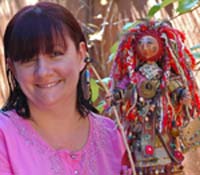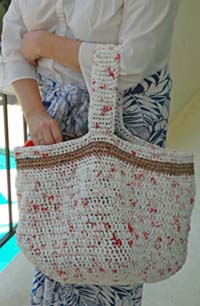|
Crafting for a Greener World
Upcycling Plastic Bags: Crochet a Reusable Shopping Bag from "Plarn"
by Robyn Coburn
Combining a Love of Crafting With an Environmental Conscience
 Introduction Introduction
Making art is one of the foundations of life in my home. In addition to filmmaking, my husband has abiding interests in art photography and jewelry design. I’m a screenwriter and textile artist focusing on art dolls and vintage upcycling. My daughter Jayn participates actively in my work and produces her own drawings and stories as a daily commentary on her emotional life. It was her interest in dolls colliding happily with my history of scenic and costume design that brought me into the world of doll making in the first place.
When I say that making art is central to our life, I mean it quite literally as well as spiritually or emotionally. Our living room is first a studio and workshop for sewing, drawing and sculpture. Every horizontal surface has some piece of work in progress waiting or tool box being stored. One large table is for the sewing machines. We have movable folding tables that we use for detail work. To eat at the dining table we must first move the beading, the clay or the laptop computer, a process eased somewhat by the use of trays and containers. Our wall-lining bookshelves are an odd mix of books and cloth storage bins. Our apartment is, frankly, way too small.
I’m very grateful because it is unschooling that allows us to focus on artistic pursuits. If Jayn were in school, or doing school-at-home, so much of her time and energy would be devoted perforce to activities outside of her passions. Moreover in school settings making art is often seen as in service to other areas of academics – the “do music because it makes you better at math” idea, rather than as intrinsically valuable. There is nothing like curriculum design to suck the passion out of any subject. Plus, it would drive Jayn nuts to be told what or how to draw every day or, worse, prevented from drawing whenever she wanted.
At home, we are fortunate to consider all our art making as interconnected, relationship reinforcing, swirling and integrated into our lives. We have found creativity to be a gateway to all kinds of other knowledge and skills, picked up in passing, like a happy side effect. There is barely a moment when we aren’t appreciating some object of beauty – natural or human-made. We are never stuck for something to do, since wherever our eyes come to rest we see something that inspires us to ask, “What shall I make?”
Increasingly, I seek ways to unite my love of arts and crafts with the environmental beliefs I hold dear. Twenty years ago I was working for Greenpeace. Soon after, I worked at the Energy Research, Development and Information Centre at the University of New South Wales in Australia, a clearinghouse for information about innovative energy research continuing all over Australia. My mind was awakened to many of the ecological issues and quandaries that still plague our world. Much of my life in theater was founded on using as few materials as possible, revamping and reusing scenic elements, remaking costumes and avoiding waste. All this makes financial sense, as well as being spiritually satisfying. Now I want to retain that green awareness in my arts practice. I find that one of the most profound things I can do is repurpose materials that might otherwise be discarded in the service of art and practicality.
And that is what this column will be about.
Crochet With Plarn 
As well as making art dolls, I crochet plarn baskets. “Plarn” is plastic yarn made from HDPE bags. It’s no secret that single use plastic grocery bags are an environmental nightmare. I live on a coast and the sadly devastating effects of plastic bags on marine life are well documented. Surprisingly, eighty percent of HDPE bags are made from natural gas rather than petroleum, but I think there are better uses for natural gas, like super efficient instant gas hot water heaters.
I’ve been carrying my own cloth bags to the grocery store for years and I keep one in my purse for serendipitous shopping moments. But somehow or other, I still end up with plastic bags coming into the house. I could place them in the recycling bins at the store to be high-heat reprocessed into other plastic products including non-woven tote bags and lumber. Unfortunately, many more bags are still being used and discarded than recycled. Colored bags usually must be separated manually from the translucent white. Contaminants such as paper or other packaging amongst the plastic bags sometimes result in whole loads being tossed rather than processed.
Unfortunately, recent research shows San Francisco’s well intentioned 2007 program to outlaw plastic bags may have backfired. Far from encouraging people to bring their own cloth bags, the ban has created a spike in the use of resource-hungry paper bags. While paper bags can be craftily repurposed and recycled along with other paper, they don’t have the one characteristic about plastic that makes its use for throwaway items so problematic – durability.
I was searching for a crafty solution that would take advantage of that permanence. Fusing was one alternative. People make cool art, tote bags and raincoats from fused bags, but I didn’t wish to subject my family and apartment complex neighbors to the inevitable fumes. Then I came across a crochet project, the “Hyperbolic Coral Reef” and the work of the amazing fiber artist Helle Jorgensen. It is her clearly illustrated online tutorial that showed me how to make plarn by folding plastic bags lengthwise several times and cutting off the bottom and handles.
I use scissors; others swear by cutting wheels. I fold the length in half and cut. Then I cut the resultant strips in half again. This makes four 2-½ inch (6cm) wide loops. I can make yarn from these or cut the yarn in half again making just over 1 inch (3cm) wide loops.
To join, loop one circle through the other and back through itself. Pull evenly on all four strands at once when tightening the join to avoid a stretched, weakened section or a break. I find that knots result in a basket that is raggedy looking so I remove any loops that tear open. Attach the next loop at the very center fold of the prior loop, to keep it even.
That’s all there is to it, other than to just keep going until you have enough to make something useful. You can knit or use a round or bar loom with plarn but I crochet. I use the wider yarn with a 10.0mm/N hook for solid, self-supporting baskets. For softer tote bag style baskets, I use a 5.75mm/J hook with the narrower yarn.
I’m also an improviser, so I just single crochet a circle until I like the size of it, then I go vertically with double crochet (US), in Australia called treble, until the height is about the same as the diameter, and then I single crochet either one strap for my elbow or two rim handles. A medium-sized basket takes about 80 plastic bags.
For me, there is still an ethical dilemma in using something for my own purpose that should never exist in the first place. I decided to use only post-consumer bags for my plarn, including the thin produce bags, which make shiny baskets. I don’t buy packaged trash bags to cut up or colored plastic twine from the hardware store. My friends and neighbors save their bags for me and I sometimes raid the recycling bins, especially if I notice colorful bags in there. I suppose I am saving the store a few pennies haulage for those bags and my particular repurposing method at least avoids the chemical and energy use that the industrial processes entail.
People are fascinated by my baskets. In making art from recycled materials, I like to highlight rather than disguise the source material. I am currently crocheting a series of plarn figures as commentary on plastic bags in the environment – a shopper, a beach goer and – my daughter Jayn’s idea – a scuba diver from dark colored bags. I’ve been keeping my bag trimmings and other soft plastic packaging to use as stuffing for these figures. I look forward to the happy day when these sculptures will be oddities because plastic grocery bags have faded into history.
After a long career designing for theater and independent films, Robyn Coburn finds her joy as an unschooling mother who also writes and crafts. She has been a confirmed greenie since working for Greenpeace during her college years in Wollongong. Robyn is currently working on two crafty books, a fairy tale screenplay, and a TV series about doll making and collecting. She lives in Los Angeles with her husband James and ever inspiring daughter Jayn. Contact her by email or visit her website to view her work.
|

